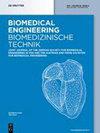基于小波变换的噪声图像的深度学习乳腺癌分类
IF 1.8
4区 医学
Q4 ENGINEERING, BIOMEDICAL
引用次数: 8
摘要
在本研究中,乳腺癌的良性或恶性分类是使用组织病理学程序,医学成像技术之一获得的图像。首先,在使用的数据集中对图像添加不同类型和不同强度的噪声。然后,利用小波变换(Wavelet Transform, WT)对噪声图像进行去噪处理。通过评价图像的峰值信噪比(PSNR)值来确定去噪过程中的性能指标。考虑到PSNR值,高斯噪声类型比其他噪声类型具有更好的效果。高斯噪声类型下的PSNR值最佳。然后,使用深度学习技术之一的卷积神经网络(CNN)对去噪后的图像进行分类。在这个分类过程中,我们使用了提出的CNN模型和VggNet-16模型。从分类结果来看,本文提出的CNN模型比VggNet-16获得了更好的分类结果。在噪声强度为0.3的高斯噪声数据集上获得了最佳性能(86.9%)。本文章由计算机程序翻译,如有差异,请以英文原文为准。
Classification of breast cancer with deep learning from noisy images using wavelet transform
Abstract In this study, breast cancer classification as benign or malignant was made using images obtained by histopathological procedures, one of the medical imaging techniques. First of all, different noise types and several intensities were added to the images in the used data set. Then, the noise in images was removed by applying the Wavelet Transform (WT) process to noisy images. The performance rates in the denoising process were found out by evaluating Peak Signal to Noise Rate (PSNR) values of the images. The Gaussian noise type gave better results than other noise types considering PSNR values. The best PSNR values were carried out with the Gaussian noise type. After that, the denoised images were classified by Convolution Neural Network (CNN), one of the deep learning techniques. In this classification process, the proposed CNN model and the VggNet-16 model were used. According to the classification result, better results were obtained with the proposed CNN model than VggNet-16. The best performance (86.9%) was obtained from the data set created Gaussian noise with 0.3 noise intensity.
求助全文
通过发布文献求助,成功后即可免费获取论文全文。
去求助
来源期刊
CiteScore
3.50
自引率
5.90%
发文量
58
审稿时长
2-3 weeks
期刊介绍:
Biomedical Engineering / Biomedizinische Technik (BMT) is a high-quality forum for the exchange of knowledge in the fields of biomedical engineering, medical information technology and biotechnology/bioengineering. As an established journal with a tradition of more than 60 years, BMT addresses engineers, natural scientists, and clinicians working in research, industry, or clinical practice.

 求助内容:
求助内容: 应助结果提醒方式:
应助结果提醒方式:


